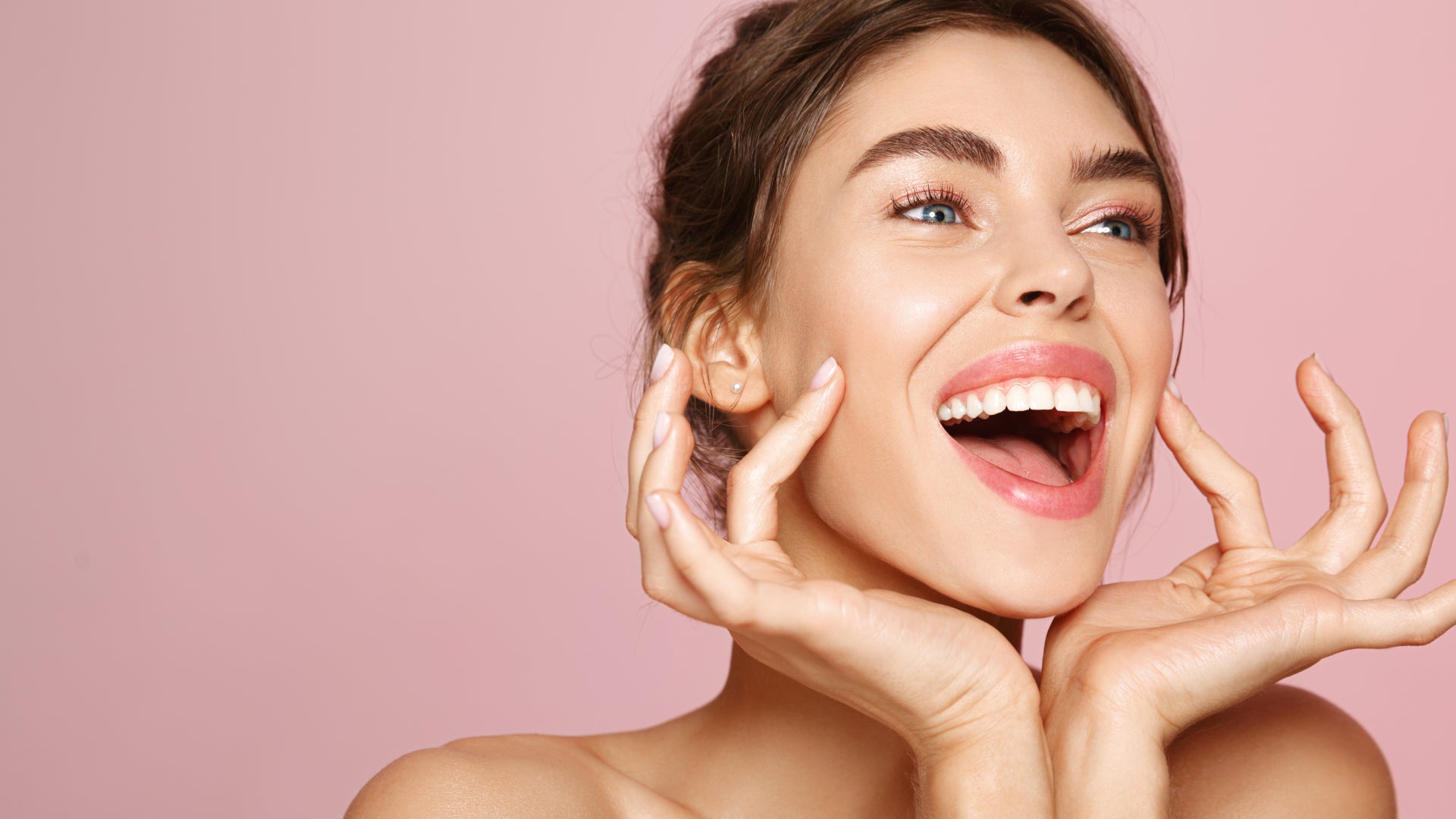
True Radical Honesty From Our Community
What To Do If You Hate Those Fine Lines Around Your Lips
Read MoreAdvice for all of your skin care needs
- all articles
- Acne
- Anti-Aging
- Collagen
- Combination Skin
- Company Announcements
- dry skin
- Exfoliation
- Eye Care
- Facial Redness
- Grooming
- Holidays
- Hyaluronic Acid
- Niacinamide
- Oily Skin
- Retinol
- Sensitive Skin
- Skincare
- Skincare Guide
- Skincare ingredients
- Skincare Routine
- Skincare Tips
- Sun Protection
- Toner
- Vegan Skincare
- Vitamin C
- view all
- Acne
- Anti-Aging
- Collagen
- Combination Skin
- Company Announcements
- dry skin
- Exfoliation
- Eye Care
- Facial Redness
- Grooming
- Holidays
- Hyaluronic Acid
- Niacinamide
- Oily Skin
- Retinol
- Sensitive Skin
- Skincare
- Skincare Guide
- Skincare ingredients
- Skincare Routine
- Skincare Tips
- Sun Protection
- Toner
- Vegan Skincare
- Vitamin C
-
Skincare ingredients can be confusing, but when it comes to collagen stimulation and wrinkle reduction, peptides are worth knowing about. Here’s what we know…
If you’ve ever found yourself confused by skincare ingredients don’t worry, you are not alone. Mysterious ingredients like kojic this and azelaic can dumbfound even the biggest skincare aficionados. But while they might sound super intimidating, these science-based actives are often some of the most effective ingredients you can use on healthy aging skin.
On that note, let’s talk about peptides. Major news in skincare right now, peptides are short chains of amino acids which, as you know, are the building blocks of protein. Like tiny little messengers that communicate with your skin at a cellular level, peptides deliver a whole host of incredible benefits, triggering specific responses like skin barrier repair and collagen production. By telling the cells exactly what to do and accelerating healing, renewal and rejuvenation, they’re vital for the health of your skin.
A Quick Lesson On The Different Types Of Peptides
Not only are there thousands of active ingredients available in skincare, but there are tons of peptides alone: often with hand-scratching names, numbers and spellings. Here’s a quick run-through of the four main peptide types to know…
Signal Peptides: the most common peptides found in skincare, these send signals to specific cells prompting them to produce collagen, elastin and other important proteins. Examples include Matrixyl 3000, palmitoyl tripeptides and palmitoyl oligopeptide.
Carrier Peptides: these peptides work by transporting essential minerals and nutrients to the skin to aid healing and encourage collagen synthesis. They’re like the delivery systems of the peptide world. The most common and well-researched are copper peptides.
Neurotransmitter Peptides: by targeting muscle contractions, these peptides are thought to relax the facial muscles thus helping to soften expression lines and delay etched-in wrinkles. Acetyl hexapeptide-8 (aka Argireline) and tripeptide-3 (aka Syn-Ake) are popular examples.
Enzyme-Inhibitor Peptides: great for strengthening and preserving the skin, these work by blocking certain enzymes that are known to break down collagen and elastin. Matrixyl 3000 also comes under this umbrella, as does acetyl hexapepetide-8.
The Power Of Peptides In Skincare
The great thing about peptides is that, unlike larger proteins which are unable to penetrate the top layers of the skin, they're small enough to communicate with the skin at a much deeper, cellular level. This makes them a must in any skincare routine because the benefits are huge. Keep scrolling to learn about the most important benefits of peptides.
1. All The Collagen Love
Undoubtedly the biggest draw for including peptides in your skincare routine is for their proven abilities for boosting collagen production. With the exception of neurotransmitter peptides, they all work hard to increase collagen synthesis, some by more than 100 percent.
Signal peptides, for example, send direct messages to the dermal fibroblasts – the fibrous connective tissue cells that, among other things, are responsible for producing collagen, elastin and hyaluronic acid. They basically give these cells a gentle nudge to work harder and faster. What does that mean for your skin? Strength, structure, radiance, lift, smoothness and youthfulness. Need we go on?
2. Softer-Looking Wrinkles
Of course, more quality collagen in your skin automatically means you will age more slowly so signal peptides, carrier peptides and enzyme-inhibitor peptides are the bee’s knees for keeping your fine lines and wrinkles under control. But don’t forget neurotransmitter peptides like acetyl hexapepetide-8. While these don’t improve collagen production, per se, they temporarily work to relax your facial muscles – kind of like Botox without the needles.
Don’t get us wrong, topical skincare is never going to offer the kind of dramatic wrinkle reduction effects you’ll get from injectable treatments, but with consistent use, neurotransmitter peptides show great promise for helping to soften the visible appearance of expression lines.
3. A Better Barrier Function
Carrier peptides are incredible for improving wound healing and strengthening the skin’s barrier function. Quick reminder: your barrier function is the super important but extremely fragile uppermost layer of the skin, aka the stratum corneum. This protective layer works relentlessly to help your skin retain moisture, while keeping nasty things like allergens, irritants and pollutants from penetrating through the skin and causing a negative reaction. As skin ages and life (stress, UV radiation, pollution) gets in the way, this barrier can become compromised, allowing moisture to escape and irritants to get in. Cue dryness, dehydration, sensitivities and all sorts.
All this is why barrier care skin formulations are so important. And peptides check that box with bells on. Copper peptides, in particular, have shown to significantly increase skin thickness and elasticity while encouraging the skin’s natural repair process.
4. Youthful Skin That Snaps Right Back
While collagen is vital for the look and feel of healthy skin, elastin is equally as important. Elastin is another structural protein in the skin but while collagen gives strength and stability, elastin allows it to stretch, flex and bounce back with your face and body's movements and expressions. It basically ensures that your skin remains firm and smooth, rather than saggy and lax.
Elastin production also decreases with age (no surprises there!), causing your skin to lose its natural, bounce-back quality. But good news: signal peptides stimulate elastin synthesis, encouraging your skin to retain its plump youthfulness.
5. Awesome Pore Control
Your pores are a crucial part of the structure of your skin. They allow important liquids, particles and gases to pass through the surface, helping to regulate body temperature and lubricate the skin. They can also (annoyingly!) stretch and appear larger with age as collagen and elastin fibers become weak and the walls of the pores become equally slack and kind of baggy-looking.
Enter the collagen and elastin-boosting powers of peptides. Stronger proteins in the skin = tighter-looking pores. Makes sense, right?
How To Work Peptides Into Your Skincare Routine
The key to getting visible results from peptides in your daily regime is to go for leave-on formulations that can be layered underneath your moisturizer. AKA, the mighty serum.
Search out peptide serums that contain a few different types in order to maximize their benefits. Our Peptide Facial Serum, for example, is crafted with an incredible peptide complex blend including palmitoyl tripeptides-1 and -5, plus palmitoyl tetrapeptide-7, all of which are lauded for their collagen-pumping, elastin-boosting, hyaluronic acid-enhancing abilities. Oh, and Peptide Eye Gel is another skincare great that shouldn’t be ignored.
Because neither should the skin around your eyes.
Why Peptides Could Be The Missing Link In Your Skincare Routine
read more -
The season of sun, sea and sand means that protecting your skin is more important than ever. Here’s how to ensure your skin is safe and guarded from UV damage this summer – and beyond.
Feel like your sunscreen game is a little off? While some SPF slip-ups are harmless (applied too much? Not a problem!), some common mistakes can – and will – unknowingly damage your skin and speed up the aging process.
Not down with that? Then take note of the following to make sure you know exactly how to keep your skin safe from the sun's perilous ways.
Mistake #1: Not applying enough sunscreen
The most common mistake, and arguably the most important one to rectify, is applying too little sunscreen. According to the American Academy of Dermatology (AAD) most people only apply around 25-50 percent of the recommended amount of sunscreen. And that’s not good enough because if you don’t apply enough you’ll starve your precious skin of the protection it rightly deserves.
The general rule of thumb is that you need about a shot glass full of sunscreen lotion to cover your entire body, and 1/2 teaspoon for your face and neck combined. It feels like a lot, but trust us, it's worth it.
If you’re using our super concentrated SPF 30 Mineral Sunscreen Facial Serum, however, you need only apply three to five drops under your moisturizer. It's a genius, concentrated hit of UV protection in a super lightweight serum. Figured we should mention that in case you hadn’t tried it yet.
Mistake #2: Ignoring commonly overlooked areas
You may think you’re an absolute pro at applying sunscreen but there are certain areas that almost always get forgotten about. These include your lips (gotta love an excuse for a new SPF lip balm, right?), your ears, behind the knees, the soles of your feet, your eyelids, the hairline and down your part.
Mistake #3: Forgetting to reapply your sunscreen
Reckon your sunscreen lasts all day? Afraid not. In fact, when sunscreen is exposed to direct sunlight it starts to lose effectiveness almost immediately. This process speeds up lightning fast if you’re sweating or swimming.
Experts agree you should reapply every two hours. No arguments.
When it comes to daily exposure whilst wearing makeup and not on the beach or outside all day long, this can be tricky, we get that. In these instances we like to double down with protection in the morning, applying a really good antioxidant serum like Vitamin C Super Serum +, followed by SPF 30 Mineral Sunscreen. Finish with makeup that also contains some form of UV protection, avoid too much exposure throughout the day and you should be a-OK.
Mistake #4: Only applying face sunscreen on sunny days
Just because there are clouds in the sky, this doesn’t mean UV radiation has gone on vacation. It’s still there, penetrating right through those clouds and prepared to do a real number on your skin if you let it. So don’t. According to the AAD, up to 80 percent of UV rays can still penetrate your skin on cloudy days so make sure you apply sunscreen to all areas of exposed skin (face, neck and hands) all year round. PS: this is super easy if you chose our SPF serum. Just wanted to point that out.
Mistake #5: Thinking water resistant sunscreen is waterproof
According to the FDA there is no such thing as waterproof sunscreen. How so? Because all sunscreens eventually wash off. Granted, water-resistant sunscreens are great if you’re spending time in the water, but you must remember that they do not give you all-day protection. Far from it. In fact, water-resistant sunscreens can only remain effective for up to 80 minutes, often as little as 40 minutes.
Always read the label first to check for the length of protection your sunscreen offers when swimming or sweating. And reapply regularly.
Mistake #6: Using expired sunscreen
Just like the best of us, sunscreens age. And when a sunscreen gets too old it can lose its efficacy, causing your trusted SPF 30 to be downgraded to an SPF 10 at best.
The FDA states that, unless otherwise stated, all sunscreens have to retain their original SPF for at least three years, so if you’ve had bottles hanging around longer than that, it’s time to toss them out. Not sure how old your sunscreens are? Toss them anyway, especially if the formulation has become clumpy or separated. It’s simply not worth the risk.
Going forward, it’s wise to write the month and year on the back of the bottle so you know when you bought it and can be vigilant when it’s had its day. Also, remember to store it properly – out of direct sunlight and never in a hot car or garage as this could accelerate the degradation process.
Mistake #7: Applying sunscreen too late
Mineral sunscreens like ours have the edge over chemical formulations because they work immediately, reflecting UV radiation from the surface of your skin as soon as they’re applied to the skin. Chemical sunscreens, however, need to be absorbed by the skin before they get to work so they must be applied a good 20 minutes before sun exposure. This means that applying your chemical sunscreen after you leave the house or get to the beach, park or pool is simply too late.
No matter what type of sunscreen you use, it’s smart to apply it before getting dressed in the morning. Not only are you less likely to miss a spot when you’re not rushing, but you know that as soon as you go outside, you’re protected for at least a few hours.
Mistake #8: Believing SPF 60 is twice as effective as SPF 30
The SPF rating of a sunscreen can be tricky to get your head around but it’s important to understand it (if only a little).
First, never go lower than a broad-spectrum SPF 30 formulation. Most experts agree that SPF 30 is the sweet spot because it blocks around 97 percent of UV radiation. Of course, going above this will block more but the increments are minimal. So that SPF 60 you reckon allows you to stay in the sun for double the time? Nonsense. Doubling the SPF rating does not double your level of protection. The truth is, SPF 60 only blocks maybe one or two percent more than SPF 30.
Also, don’t forget to look out for that extra ‘broad-spectrum’ part. SPF ratings only denote the level of UVB protection whereas a broad-spectrum product shows that it protects your skin from both UVA and UVB radiation. That’s important stuff so if you don’t see this on your label, switch it out for something far superior.
And we can help you out with that, right here...
The Sunscreen Mistakes You Never Want To Make
read more -
No doubt you’ve heard of collagen and it’s vital role in the health of your skin. But if that’s where your knowledge ends, read on for some important facts about collagen which promise to help you maximize the look and feel of your complexion.
Collagen is everything when it comes to healthy skin. We could pretty much end this blog post right there but we know that, as skincare connoisseurs, you like to understand more about how your skin functions and what you can do to help it age beautifully. So let’s delve a little deeper into this essential protein, shall we?
As the most abundant component within the connective tissues of the skin, collagen accounts for somewhere between 70 and 80 percent of the skin’s dry weight. It has a dense, fiber-like structure that forms a chain of proteins and, together with its cousin, elastin, it fortifies the entire structure of your skin. Think of it as a kind of internal scaffolding system that gives your skin strength, elasticity and a plump, youthful appearance.
There are many different types of collagen, but over 90 percent of that found in the human body fits into five types. Of those five, type one is the star of the show and found packed into the skin’s dermis where it provides structure and form. The others work alongside it to aid strength, growth, healing and repair, while elastin gives the skin stretch and bouncebackability (don’t you just love that word?).
Together, these important proteins provide the absolute foundation for healthy skin, ensuring that it functions well, and looks and feels awesome.
The Benefits of Collagen In The Skin
Improves cell turnover
Maintains firmness
Plumps and volumizes
Visibly minimizes fine lines and wrinkles
Supports elasticity
Strengthens pores
So What’s The Catch?
The kicker is that after the age of around 25 (give or take) your skin starts to lose between 1 and 1.5 percent of collagen every year. Collagen loss is an entirely natural part of the intrinsic aging process and the reason everybody’s skin eventually becomes thinner, weaker, lax, more wrinkled and less plump as it gets older. Women will especially start to notice the difference in their skin as they go through menopause because it's during this time that the rate of collagen loss really amps up.
Of course, there’s nothing you can do about Father Time, but there are many other factors at play here that are within your control. Poor sleep, chronic stress, environmental pollution and a high-sugar diet all contribute significantly to collagen degradation. And then there’s the obvious culprit: the sun.
We’ve mentioned this before, and we’ll mention it again, UV radiation is the biggest cause of external skin aging. And that’s mainly down to the way in which it messes with your collagen supplies thanks to the damaging free radicals the sun creates in the dermis of the skin. According to the Skin Cancer Foundation, photoaging is responsible for a whopping 90 percent of visible changes to the skin and those changes (none of which are particularly good!) are a direct result of cumulative sun damage. Ouch.
So what can you do to maintain decent levels of collagen in your skin, even when time is very much against you? Of course, a balanced diet, quality sleep and low levels of stress are super-important. As is a collagen-strengthening skincare routine. And that’s where we can help…
5 Of The Best Products For Your Collagen
1. Firming Collagen Day Lotion
Dry skin is no good for the aging process which is why daily moisturizer is an absolute must – no matter your skin type. Packed with vegan collagen peptides along with skin-loving ceramides, green algae and botanical superfruits, this lightweight lotion is a great way to help protect your collagen by fortifying the skin and shielding it from all those environmental bad boys we know and love/hate. It's an absolute must for anyone looking to protect the building blocks of their skin so they don’t age up lightning fast.
Because aging is great. A privilege, in fact. But it’s still nice to keep the visible signs of aging to a minimum, right?
The gold standard for stimulating collagen production is retinol. It’s been tested and proven time and again for having almost unbeatable skills at stimulating collagen synthesis. Not only that but it also provides antioxidant qualities which help to neutralize free radicals before they get a chance to break collagen down. It takes a while to reap the benefits of a retinol skincare formulation, but once you do, you will never look back.
Our fan-favorite retinol serum also contains hyaluronic acid, green tea and vitamin E to hydrate the skin and further nix those pesky free radicals. Because, yes, we think of everything.
Peptides are another great way to get your collagen supplies going. This is because, just like collagen (a protein, remember?), peptides are made up of strings of amino acids. Studies show that due to their similarities, peptides encourage your skin to produce more collagen – as well as elastin and keratin for that matter!
The thing to remember about peptides is they generally work best as a team and some are more effective than others. We believe firmly in the powers of matrixyl 3000 and palmitoyl tripeptides-1 and -5 which is why they’re carefully crafted into our Peptide Eye Gel. After all, collagen degradation is serious business when it comes to the thin, delicate skin around the eyes.
4. Collagen Boosting Skin Supplement
The truth is, great skincare doesn’t only happen on the outside. You also have to feed it from the inside with a balanced diet and perhaps a carefully crafted skin supplement.
Collagen supplements are fabulous for improving skin hydration and elasticity but many well-known brands use fish scales or animal bones/skin as their source of collagen. Now we don’t know about you, but we’re not really down with that. This is why ours are made with vegetarian collagen, combined with collagen-boosting superfoods, vitamins C and E plus biotin, a form of vitamin B that’s thought to help promote cell growth and repair. All you have to do is take two tablets each morning, with breakfast, to reap the benefits of this skin brightening and strengthening supplement.
5. SPF 30 Mineral Sunscreen Facial Serum
More impactful than arguably any other skincare formulation, a broad-spectrum sunscreen is simply non-negotiable. Not least because it will seriously help to preserve the collagen you are trying so desperately not to lose by keeping UV rays from penetrating the skin’s surface and thus stopping them from doing a number on all the good stuff in the dermis.
Hate the feeling of daily sunscreen on your skin? Then try our fantastic SPF serum which is so lightweight you’ll never know you’re wearing it. More good news: it also contains sodium ascorbyl phosphate, a gentle derivative of vitamin C which is essential for collagen synthesis.
Why Collagen Is So Important For Healthy Skin
read more -
Stay ahead of soaring temperatures and irritated skin with our easy-to-follow tips for caring for sensitive skin in the sun.
Sensitive skin can get all kinds of crazy during the summer months as the heat rises, the beach beckons and A/C gets serious. And the fact that somewhere between 50 and 70 percent of adults report having some level of sensitive skin means that potentially a whole lot of people are dealing with redness, itching, dry skin and/or discomfort right now.
Of course, there are many causes of sensitive skin, many of which are complex little beasts. But if your sensitivities are triggered by things like sunscreen, swimming, soaring temperatures and air conditioning, read on to discover the best ways to keep your skin happy this summer.
Choose Mineral Sunscreen
Sunscreen is non-negotiable, no matter your age, gender, skin color, skin type or level of sensitivities. If your skin often feels a little ‘off’ after applying SPF, however, switch to a mineral formulation that contains physical filters like zinc oxide or titanium dioxide.
Mineral sunscreens are highly regarded as the smart option for reactive skin as they aren’t absorbed into the skin. Instead they act as an invisible shield on the skin’s surface which blocks UV radiation and delivers immediate protection without causing the irritation often linked to chemical-based formulas. Both of our sunscreens are crafted with zinc oxide – in our opinion, the gold standard of sun protection – and deliver incredibly lightweight protection with a broad-spectrum SPF 30.
Say No To Hot Showers
It’s not often you want to crank up the water temperature in the summer, but should you be tempted by a hot shower or bath, know this. Scorching hot water messes with your skin’s barrier function, stripping away many of its vital oils and proteins thus leaving it vulnerable to dryness and redness. Do you often jump out of the shower and notice your skin looks red? This is a sure sign that your shower was way too hot. Turn. It. Down. Lukewarm temps are way more refreshing in the summer, anyway.
Avoid Synthetic Fragrances
Take a good look at the ingredients in your skincare regime to check for common skin irritants that could be triggering your summer flare-ups. Fragrance, for example, is known to be the number one irritant and the biggest cause of cosmetic contact dermatitis in the US so avoiding that should be your first port of call.
Other potential no-nos that have the potential to mess with your barrier function include strong surfactants like sodium lauryl sulfate (SLS) and sodium laureth sulfate (SLES), preservatives, dyes and potent alcohols like ethanol, isopropyl alcohol and denatured alcohol (aka alcohol denat). These can all strip away the skin’s natural oils, leading to dryness, redness, itching and more.
Wear Loose, Cotton Clothing
It’s super important to wear lightweight, loose-fitting clothing in the summer to minimize sweating and reduce your risk of skin sensitivities like burning and itching. This is especially important if you suffer from ongoing summertime skin issues like prickly heat or folliculitis. Organic cotton clothing is ideal but other natural fibers like linen are similarly better than man-made fabrics.
Cleanse Gently
The best cleansing technique requires the gentlest of touches – even in hot weather. Granted, it’s tempting to cleanse more vigorously in the summer when you sweat more and have extra layers of sunscreen on your face, but if you rub away at your skin using overly potent formulations your skin will not thank you for it. Think breakouts, freakouts and anything else your skin likes to do when it’s unhappy.
Instead of this utter madness, use a kind-to-skin cleanser that contains hydrating ingredients as well as those that help to remove impurities after a day in the heat. We love Vitamin C Brightening Cleanser which is formulated to suit all skin types and deep cleans the skin without drying it out. Spend a few minutes massaging it gently into your skin morning and night and rinse thoroughly with lukewarm – never hot, remember? – water.
Be Smart With Your A/C
Going inside to take a break from the heat and damaging UV rays is a smart move… but watch out for overly zealous air conditioning. A/C feels like bliss at the time but not only does it cool the air but it also removes moisture which can dehydrate your skin and give you the itch.
To minimize the risk of A/C skin meltdown (uncanny, right?), keep yours at the recommended comfortable temperature of around 78 oF. Added bonus: as well as saving your skin it’ll also save you a good wad on your utility bills.
Double Down With Moisture
Extra hydration is crucial during the summer months to help minimize the drying effects of all the summer greats – eg. swimming pools, the ocean and air conditioning – and keep your skin healthy, strong and itch-free. And the best trick for the ultimate moisturization? Layer it on with serum and moisturizer.
Hyaluronic acid, aloe and glycerin are important ingredients to look out for here as these draw water to the surface of the skin. But you must also include ingredients in your moisturizing routine that help to seal water in – otherwise it'll evaporate lightning fast meaning all that hard work will go to waste. Shea butter is a favorite of ours as it creates a lightweight seal on the surface of the skin without clogging up your pores. Jojoba oil, vitamin E and ceramides also have equally incredible moisturizing superpowers. Try the combination of Niacinamide (B3) Facial Serum (so good for sensitive skin) followed by Collagen Day Cream (ditto!).
Shower After Swimming
Chlorine is essential for pool hygiene but, if you have reactive skin, this powerful detergent can strip away at your skin’s uppermost layers, screwing up the pH level and unbalancing your skin’s delicate microbiome. The results? Anything from dryness and itching to full on eczema flare-ups.
If you love a good al fresco dip in the pool make sure to apply water-resistant sunscreen first (this’ll create a kind of barrier against chlorine disruption as well as UV damage); and shower as soon as you leave the pool. If it’s not possible to take a proper shower, rinse yourself in fresh water, then shower thoroughly at the end of the day. Same applies after going for a dip in the ocean.
The Best Ways To Care For Sensitive Skin In Summer
read more -
Neck aging is very real, so read on for some of the best skincare products for delaying fine lines, wrinkles, dryness and sagging skin on your neck.
Are you guilty of giving the skin on your neck zero attention? Warning: fine lines, wrinkles, dryness and sagging skin can creep up on your neck lightning fast. One day you’re lovingly enjoying your youthful-looking skin then before you know it, ‘bam!’ your neck looks 75 on your 45th birthday.
Why does the skin on your neck age so visibly and swiftly? Well, other than the fact that it often lacks the care and attention it deserves (entirely your fault, btw!), the structure of neck skin is also slightly different to your face. It’s thinner, for starters, which makes it more delicate and susceptible to the slings and arrows of everyday stressors like UV radiation and pollution that break down collagen and elastin and cause premature wrinkling, crinkling, crepiness and sagging. The skin on your neck also contains fewer sebaceous glands which means it lacks the sebum necessary to combat dryness and keep it soft, strong and lubricated.
But that’s not all because it doesn’t help that we’ve become a nation obsessed with our smartphones. So what, you may ask? Well, hours spent looking down whilst you scroll through YouTube videos can lead to all manner of neck, back and posture issues,. The most common and obvious to the naked eye? Horizontal bands around the neck, aka neck wrinkles or ‘tech neck.’
The good news is there are plenty of ways to deal with neck lines and wrinkles – most of which are covered right here. And our favorite? An awesome skincare routine that doesn’t stop when you reach your chin.
To follow, five of our most effective products for staying one step ahead of fine lines, wrinkles and sagging neck skin.
1. SPF 30 Mineral Sunscreen Facial Serum
We’re massive fans of treatment serums here at TruSkin and the newest addition to our serum family is a real beauty for both the face and the neck. A multi-faceted product, SPF 30 Mineral Sunscreen Facial Serum is a serum with bells on, delivering the antioxidants powers of vitamin C (or sodium ascorbyl phosphate, to be precise), alongside a broad-spectrum, all-encompassing SPF of 30 – the dermatologist-recommended level for everyday damage control. We hate to brag too much but it’s pretty much the sun protection product you’ve always dreamed of.
The thing is, though, sun protection isn't just for the face. Unless you wear scarves and turtle necks every day of your life, your neck is exposed to the elements just as much as the skin on your face, making daily SPF protection an absolute must. Also, as you now know, the skin on your neck is thin, fragile and vulnerable to premature aging so a treatment serum is going to work wonders for preserving your collagen and delaying wrinkles and a lack of firmness in the area. Simply smooth an extra drop over the neck area when you apply it to your face – after cleansing and before moisturizing. Simple.
2. Renewing Longevity Moisturizing Cream
One of the most effective ingredients for aging skin is undoubtedly retinol (more on that in a minute). However, certain types of sensitive skin don’t play well with this potent ingredient. The skin on the neck can also feel even more sensitive than that on the face, so what’s a good alternative for tackling lines and wrinkles when retinol is not a viable option? Bakuchiol.
Touted as nature’s alternative to retinol, bakuchiol offers all the same skin-rejuvenating benefits… but with fewer of the common side effects like redness, irritation and dry skin. We harness the powers of this excellent botanical in our Renewing Longevity Moisturizing Cream. Combined with hydrating aloe vera, soothing vitamin E and revitalizing snow algae it’s a winner for the face and neck area. Apply it morning and night after your serum using upwards motions to help lift and tighten the skin.
3. 6% AHA, BHA + PHA Liquid Exfoliant
As you know, a fabulous way to improve cell turnover and enhance the look and feel of your skin is to exfoliate regularly. Exfoliation encourages dead skin cells to slough away, enabling the fresh, healthier-looking ones to reveal themselves at a surface level. Of course, your skin cells do this naturally, but as you age, the process becomes slow and sluggish, allowing the old cells to sit around longer than you’d like. This can cause all sorts of issues like clogged pores, breakouts, rough texture and dull, lackluster-looking skin.
To help keep cell turnover ticking along at a decent rate, it’s smart to exfoliate two or three times a week, depending on your skin’s tolerance levels. Our 6% AHA, BHA + PHA Liquid Exfoliant is a real winner for smoothing over your neck because, instead of using physical grains which might not suit this delicate area, it’s crafted with non-abrasive glycolic acid, salicylic acid and gluconolactone, which break down the bonds between dead cells so they fall off on their own accord. Extra vitamin C also helps to brighten and protect the skin. Bonus.
4. Retinol Facial Serum
OK, back to retinol which is pretty much the queen of collagen-stimulating skincare ingredients and consistently seen as ‘the one’ for anybody over the age of 30 who’s looking to age beautifully… but not prematurely.
A derivative of vitamin A, retinol is indisputable in its powers to encourage cellular turnover and improve quality collagen in the skin. Granted, it’s not for everyone (which is where other ingredients like bakuchiol, peptides and vitamin C step in to save the day), but if you choose your formulation wisely, patch test first and go slowly, most people are able to incorporate retinol seamlessly into their skincare regime.
Our Retinol Facial Serum, for example, is super gentle on the skin because it’s partnered with hyaluronic acid and vitamin E to hydrate and help reduce irritation. It’s so good you can even apply it to the delicate skin on your neck. Just remember, the neck area can be prone to dryness and itching so apply it to this area just once or twice a week to clean skin before bed, then increase frequency only as tolerated – if at all.
5. Vitamin C Deep Hydration Night Cream
Vitamin C is the most studied and widely used topical antioxidant in skincare. And antioxidants are crucial for aging skin because they reduce oxidative stress. What’s that exactly? Good question. Oxidative stress is the damage caused by environmentally induced free radicals which, if left to their own devices, like to seriously screw up your collagen, thus accelerating the formation of wrinkles.
After cleansing at night, our Vitamin C Deep Hydration Night Cream is an absolute dream on the face and neck because it works hard to neutralize those pesky free radicals and help reduce the appearance of neck wrinkles, face wrinkles, and other signs of aging. It also contains MSM, vitamin B5, aloe vera and a whole bunch of other skincare darlings, providing your face and neck with everything it needs to wake up smoother, softer, full of life and ready to face the day.
Our Favorite Products For Tackling Neck Wrinkles
read more -
Read on for all the proof you need that sleep, alongside an awesome skincare routine and a balanced diet, is everything for beautiful, healthy skin.
‘Beauty sleep.’ How many times have you heard that phrase banded about? Funnily enough, the powers of getting your beauty sleep is not just an old wives’ tale made up to force you to go to bed at a decent hour. In fact, there’s a world of truth in it because the powers of quality sleep are almost unbeatable for the look and health of your skin.
Get your eight hours, invest in a consistent skincare routine, eat well, stress less and exercise regularly, and you’ve pretty much nailed the ideal combination for fabulous skin.
So let’s begin with arguably the most important of those five skin-saving must-dos: sleep. Sleep is crucial for every single process within the human body. From brain function and mental wellbeing to your entire physical health, without sleep, you simply would not be able to successfully live. And as far as your skin is concerned? Well, this important period of rest is when your skin undergoes a busy time of regeneration and rejuvenation.
What Happens To Your Skin When You're Asleep?
Sleep plays a crucial role in the way your skin looks and feels because sleep time equals action stations for many of its important biological processes. After a busy day fighting hard to protect itself from environmental damage from things like pollution and UV radiation, when you hit the sack, your skin goes into full-on repair mode. The following occurs...
Collagen Production Accelerates
Collagen is an important protein found within the skin that gives it optimal strength and structure. Collagen synthesis remains pretty stable during the day but when your body is sleeping, growth hormones kick in that stimulate a boost in production.
Blood Flow Increases
Strangely enough, your circulation accelerates during sleep – even more so during deep sleep. This is great news for the skin as this high level of blood delivers nutrient-rich oxygen to the cells, supporting regeneration and helping the skin to repair itself.
Antioxidant-Rich Melatonin Kicks In
Melatonin is a hormone that’s produced by the body when it’s dark. It has incredible antioxidant properties which makes it your very own damage control hormone, neutralizing free radicals and aiding repair from environmental stressors like pollution and UV radiation.
Cellular Turnover Almost Doubles
Skin cells are constantly renewing themselves throughout the day, replacing dead cells with new ones to keep your skin looking fresh and radiant. This renewal process increases when you’re asleep which expedites repair from environmental damage. Say no more.
Cortisol Levels Drop
Otherwise known as the ‘stress hormone’ (which says it all), cortisol is an important hormone that keeps you aware and alert throughout the day. When you’re asleep, cortisol levels drop to reduce stress on the body and help your skin optimize this crucial recovery period.
It’s A Fact: Poor Sleep Can Seriously Impact Your Skin
Miss out on the recommended seven to nine hours of sleep each night and you deprive your skin of all the great stuff it goes through during these vital hours of regeneration and recovery. What does this mean for your complexion? Nothing good.
Disrupting collagen production probably creates the biggest impact on the skin as collagen is the absolute foundation for healthy skin. When you deprive it of this important time your levels of collagen become depleted which has a knock-on effect across many areas of skin health. Hydration becomes impaired, your barrier function gets compromised and all manner of premature aging signs start to crop up including fine lines, wrinkles, dark spots and sagging skin.
Couple this with less time for a) antioxidants to work their wonders, b) blood flow to nourish the skin and c) cellular turnover to kick into gear and dull, dehydrated skin is practically inevitable. Not to mention the fact that high levels of cortisol encourage sebum production and increase inflammation. Which sounds like the perfect recipe for breakouts.
Because it is.
5 Tips For Improving Your Sleep
1. Keep A Regular Schedule
According to the Mayo Clinic, one of the most important ways to get a better night’s sleep is to go to bed and get up at a similar time each day so that you get around seven or eight hours of quality sleep daily – yes, even at the weekends. Consistency is vital for maintaining a successful sleep-wake cycle and thus allowing your skin the time to regenerate.
2. Optimize Your Sleep Environment
Make sure your bedroom is dark, quiet and at a cool, comfortable temperature. Studies show that the optimum temperature for restful sleep is somewhere between 60 and 67 degrees Fahrenheit, so aim for that if you can. If your curtains aren’t dark enough, invest in a sleep mask and if noise is an issue, ear plugs work wonders.
To truly help your skin do its best as you sleep, cleanse, tone, treat and moisturize before bed every night. We love the combination of Retinol Facial Serum followed by Vitamin C Deep Hydration Night Cream. Oh, and you might want to think about purchasing a humidifier for your bedroom – especially if you live in a dry climate. This’ll help stop your skin from becoming dehydrated overnight.
3. Avoid Screen Time Before Bed
Staring at any kind of light-emitting screen before bedtime will mess with your circadian rhythm and delay natural melatonin production so put your phones, tablets and laptops down at least an hour before you hit the sack. Come on people, you’ve got this!
4. Limit Late Night Treats
Caffeine and alcohol stimulate your nervous system, and their effects take hours to wear off which stops your body from relaxing for quite some time. Not the most sensible idea before bed, so best not to indulge too heavily.
Similarly, don’t hit the sack hungry or completely stuffed full of rich food. This can cause discomfort and stop you from falling asleep. Small, healthy snacks like raw veggies, fruit or natural yogurt are fine, but a late-night, three-course meal? Nope.
5. Manage Your Thoughts
If you have a lot on your mind, a great trick to stop you from tossing, turning and worrying all night is to jot down your thoughts or worries. Make a ‘to-do’ list if you need to, or simply make a note of random thoughts and ideas. This is a very powerful way to get things off your chest and give you a clear mind for a better night’s sleep.
And as we've discovered, a better night's sleep goes a long way to giving you healthier-looking skin.
Great Sleep = Healthier Skin: Your Guide To Better Sleep Starts Here
read more






















